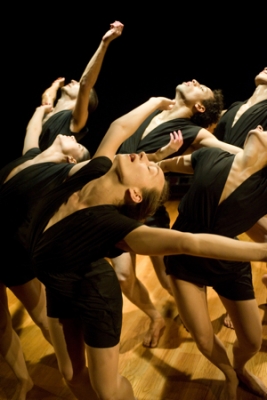Blush: A Fearless Monument

Blush, which was performed by Gallim Dance from New York City, at the Playhouse Theatre on March 23rd and 24th was, simply, a boundary shattering monument to the extremes of originality, creativity, and excellence in choreography and dance, as well as lighting and music. I left the theatre breathless, as though winded by the exhilaration of merely watching this company perform their exquisitely detailed and extremely demanding piece.
Perhaps what is most remarkable about Blush, which is choreographed by Andrea Miller, is its tremendous spectrum that occupies emotional places ranging from derangement to feverous joy and from anger to tenderness. But it’s not just the emotional range that is worth noting. The dancers are all extraordinarily athletic and strong, but within that power is an unusual attentiveness to nuance and detail that is articulate and graceful.
Rarely have I seen a group of six dancers – 3 male and 3 female – dance as forcefully as Olympians and as delicately as the light catching the strands of a spider’s web. And they do all this with technical excellence and with amplified emotion that is accessible and never clichéd or pretentious.
The choreography itself is some of the most original and interesting that I have seen. Miller makes use of odd isolations, disconcerting repetitions, powerful gestures and some very unusual angles to bring her audience into a world that is entirely unique, at times disturbing and ominous, but ultimately uplifting. Blush opens with a lone male dancer experimenting with movement that seems, from the very beginning, to be almost alien, making use of angular motions and severe isolations that are both extreme and strangely beautiful. This oddly compelling vocabulary is developed into a fantastically sophisticated language all its own during the 60 minutes of this piece.
With the bare set and minimalist, but very effective lighting that makes clever use of footlights and spotlights by turns, Miller is able to emphasize the sinewy suppleness of her dancers, who are at all times dancing at the far edge of the choreographer’s imagination. I was surprised when, after the show, I read that the piece is meant to be an exploration of the feeling of blushing. I found this piece to be much darker, much richer than what I would expect of a journey into the human capacity to blush. In fact, without a moment of what I would call imitation, this piece brought to mind such things as blind creatures emerging from a dark swamp. It reminded me of the frightening monkeys in The Wizard of Oz, and it made me thing of the peculiarity of crabs that run, delicately, sideways, contrary to the orientation of the rest of the world. My 60 minute immersion in the universe of Blush also brought me back to the year I spent in Japan, in particular to the day I arrived there and found myself in a place so foreign, so disorienting that I felt that I might as well as arrived on Mars. And I was thrilled. Miller’s work is similarly challenging to what I felt that day; her work is a mountain of inspired, perhaps even visionary choreography whose summit I would want to reach again and again.
Without being derivative, Blush also makes use of an aesthetic that is reminiscent of Butoh. The dancers are painted or powdered in white, and this emphasizes their gestures as well as their very expressive faces. As this show is so demanding in its athleticism – the dancers, by turn, practically perform acrobatics – all of the dancers end up appearing gloriously disheveled, white smeared from their bodies revealing patches of red; and this grittiness serves to emphasize the powerful emotions contained in this fearless piece.
One of the most powerful sections of this work might be the duet between two of the male dancers. Without imitating sex, this section unflinchingly conveys the full power of male sexuality, and to do this with two men embracing, launching themselves into each other’s arms, pushing each other to their limits is gutsy and daring.
Other notable moments include a great deal of acrobatic maneuvering by which one of the female dancers seems about to be catapulted into the audience – repeatedly – leaving many of us in my row audibly sucking in our breath. There are also duets that are fierce and lustful as well as a final section that has the dancers dancing and running on the stage with the energy of sprinters, as though they’ve only just begun.
I have no idea how one choreographer manages to avoid every cliché and succeeds in creating choreography that is so vivid, so original and fully realized, while also being technically excellent and emotionally rich, but Miller has done it, and with Blush, she has reached a rare and spectacular pinnacle. This type of work is important because it is a metaphor for what is possible, for what the imagination is capable of, and I think this applies to art and to all of life. I am, myself, richer for having seen Blush; this work is a monument of not only beauty, but inspiration and even aspiration.



